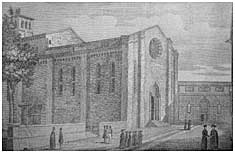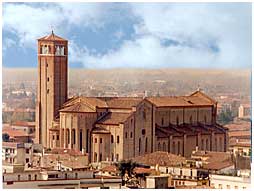| THE CHIESA DI SAN NICOLÒ (CHURCH OF ST. NICOLÒ), Via San Nicolò - Treviso |
| |
| At the beginning of 14th century the Chiesa di San Nicolò was built by
Dominicans thanks to also friar Niccolò Boccalino’s legacies, well-known as "Pope Benedetto XI". The Church
was located west of the centre where the most urbanized area ended and the uncultivated lands began in Treviso. |
| |
|
The history of the Church erection was marked
by the collapse of a bell tower, which demolished most of underlying chapels and by an interruption caused by
plague, which affected Treviso in the first half of 14th century.
The Chiesa di San Nicolò represents a moment of transition between the strong Romanesque style and the
Gothic style from transalpine provenance by its simple forms, but stretching upwards, by massive outside walls
which are interrupted by thin embrasures. |
 |
 The Chiesa di S. Nicolò - 1846
The Chiesa di S. Nicolò - 1846Antonio Nani's engraving Chiesa di san Nicolò (Biblioteca Comunale di Treviso) |
| |
|
| The columns, dividing the indoor space up into three
naves, support the timber roof with circular section; but they are also the background of some frescoes by Tomaso
da Modena (the second column on the left) and by other painters of his school. |
| |
|
 |
 |
The naves of the Church end with three apses;
the main is the presbytery where you may see a sculptural part by Antonio Rizzo and the pictorial part by Lotto.
You may see an organ by Gaetano Callido (1778 - 1779) and near a wide fresco representing St. Cristoforo as far
as the trusses on the external wall of right nave. In the next Dominicans chapterhouse there is a wide fresco
which covers whole perimeter of the broad room, it represents the distinguished Dominicans, everyone is
portrayed inside a own niche - private room. |
|
| |
Tomaso da Modena makes this wide fresco,
which represents a period of stylistic and iconographic reconsideration of way of representing in
grotesque manner.
In the half of 19th century the Chiesa di San Nicolò was restored thanks to also funds allocated
to preserve the artistic heritages.
Thus the roof and the ceiling were replaced and the red marble from Verona was used to floor the church;
the extensions, which didn't agree with the style of building, were removed. |
| |
|
| Unfortunately the church was bombed heavily
in the Second World War, in 1944 some strong bombings caused the breaking down of the roof and the demolition
of a part of bell tower. |


